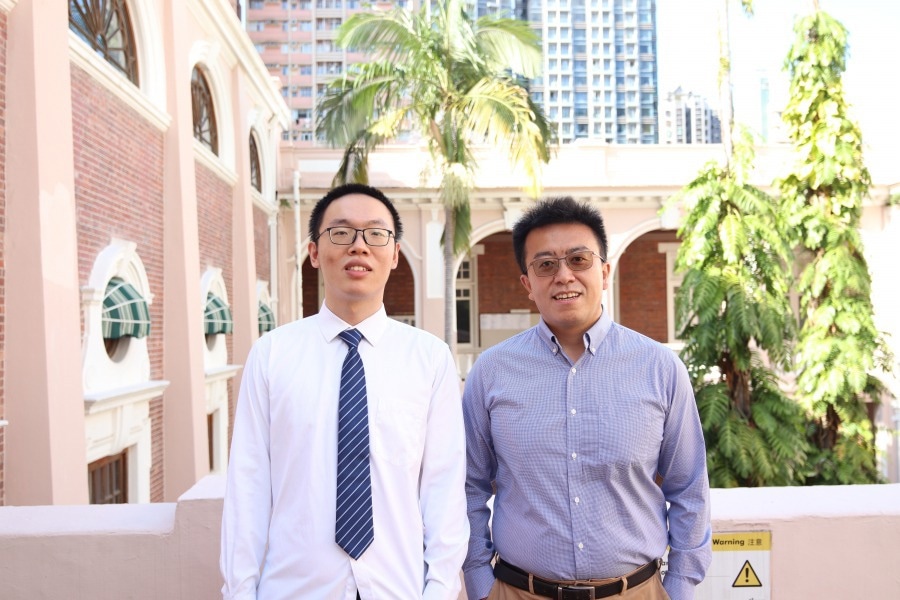By identifying the controllable nonlinear Hall effect in twisted bilayer graphene, a group of international researchers led by The University of Hong Kong (HKU) and The University of Science and Technology (HKUST) achieved a significant advancement in the field of quantum materials
 PhD student Xu Zhang (on the left) and his advisor Dr Zi Yang Meng from the Department of Physics at HKU. Image Credit: The University of Hong Kong
PhD student Xu Zhang (on the left) and his advisor Dr Zi Yang Meng from the Department of Physics at HKU. Image Credit: The University of Hong Kong
The research sheds new light on the distinctive characteristics of two-dimensional quantum moiré materials. It holds promise for a wide range of applications in industries like new materials and quantum information to achieve terahertz detection with ultra-high sensitivity at room temperature. It was published as an Editors’ Suggestion article in the esteemed physics journal Physical Review Letters.
The team, which included Professor Kai Sun from The University of Michigan, Ph.D. student Xu Zhang and his advisor Dr. Zi Yang Meng from the Department of Physics at HKU, Professor Ning Wang from the Department of Physics at HKUST with his postdoctoral researchers Meizhen Huang and Zefei Wu, and Professor Ning Wang from the Department of Physics at HKUST, conducted extensive research using a combination of theory, computation, and experiments.
They found that the Berry curvature dipole moments, which are fundamental to the Hall effect, can be readily controlled and modified by varying the dispersion of the topological flat bands in twisted bilayer graphene.
The researchers discovered that the dispersion of the flat bands in twisted graphene can be easily controlled using a vertically applied electric field, and they noticed a clear nonlinear voltage response in the longitudinal direction when a transverse driving current was supplied.
The reaction showed increases, reductions, and changes in direction when the applied field, strain, and twist angles were adjusted. These experimental findings supported their theoretical calculations’ flawless explanation of how the sliding of the Berry curvature hotspots in the topological flat bands affects the nonlinear transport behavior.
The influence of the moiré potential and twist angle in the controllable nonlinear Hall effect of twisted bilayer graphene was also studied by the researchers. They discovered that the size of the observed nonlinear response was significantly influenced by the intensity of the moiré potential. The researchers were able to adjust the moiré potential and, therefore, control the nonlinear transport behavior by changing the twist angle between the layers of graphene.
The realization of quantum Hall materials and nonlinear Hall effects in new experimental platforms has enormous promise due to the controlled nonlinear Hall effect observed in twisted bilayer graphene. The nonlinear Hall effect in graphene, which is fueled by low-frequency currents, is not constrained by voltage thresholds or transition times like it is in conventional electronic devices.
With large responsiveness and extremely high sensitivity at ambient temperature, this offers opportunities for applications in frequency multiplication and rectification employing low-frequency currents, particularly in the terahertz frequency range.
This breakthrough in the study of quantum materials—the controlled nonlinear Hall effect in twisted bilayer graphene—is a result of this finding. It opens up new avenues for research and applications in quantum information, novel materials, and condensed matter physics. This cross-institutional collaboration in research also highlights the value of multidisciplinary collaboration in expanding the frontiers of knowledge.
The Hong Kong Research Grants Council's Area of Excellence Scheme (AoE 2D materials) and Collaborative Research Fund (CRF many-body paradigm in quantum moiré material research) provided funding for this study, demonstrating the government of Hong Kong’s forward-looking approach and commitment to the study of two-dimensional quantum materials, particularly quantum moiré materials like twisted graphene.
The ‘Blackbody’ supercomputer of the Department of Physics at HKU, along with the High-Performance Computing Platform HPC2021 at the Information Technology Services, was used for the large-scale numerical simulations carried out in this study.
Journal Reference:
Huang, M., et al. (2023) Intrinsic Nonlinear Hall Effect and Gate-Switchable Berry Curvature Sliding in Twisted Bilayer Graphene. Physical Review Letters. doi:10.1103/PhysRevLett.131.066301